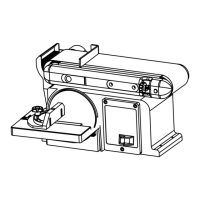Troubleshooting
Service on these tools should only be performed by an authorized, qualified technician.
SYMPTOM
PROBABLE CAUSE CORRECTIVE ACTION
Sanding Grains easily
rub off belt or discs.
1. Sanding belt/disc has
been stored in an incorrect
environment.
2. Sanding belt/disc has been
damaged or folded.
1. Ensure sanding
accessories are stored
away from extremely hot
or dry temperatures.
2. Store sanding accessories
flat – not bent or folded.
Deep sanding grooves
or scars in workpiece.
1. Sanding belt/disc grit is
too coarse for the desired
finish.
2. Workpiece sanded across
the grain.
3. Too much sanding force on
the workpiece.
4. Workpiece held still against
the belt-disc for too long.
1. Use a finer-grit sanding
accessory.
2. Sand with the grain of the
wood.
3. Reduce pressure on
workpiece while sanding.
4. Keep workpiece moving
while sanding on the
sanding accessory.
Sanding surface clogs
quickly.
1. Too much pressure against
belt/disc.
2. Sanding softwood.
1. Reduce pressure on
workpiece while sanding.
2. Use different stock,
different sanding
accessories, or accept that
this will happen and plan
on cleaning or replacing
belts/discs frequently.
Burns on workpiece. 1. Using a sanding grit that is
too fine.
2. Using too much pressure.
3. Work held still for too long.
1. Use a coarser-grit sanding
accessory.
2. Reduce pressure on
workpiece while sanding.
3. Do not keep workpiece in
one place for too long.
Motor will not start. 4. Low voltage.
5. Open circuit in motor or
loose connections.
6. Blown fuse or breaker.
4. Check power source for
proper voltage.
5. Inspect all lead
connections on motor for
loose or open connections.
(Send for Servicing)
6. Short circuit. (Send for
Servicing.)
7. Improper match between
tool and circuit, fuse or
breaker.
Motor will not start –
fuses or circuit breakers
tripping or blowing.
1. Short circuit in line, cord or
plug.
2. Short circuit in motor or
loose connections.
3. Incorrect fuses or circuit
breakers in power line.
1. Inspect cord or plug for
damaged insulation and
shorted wires.
2. Inspect all connections on
motor for loose or shorted
terminals and/or worn
insulation.
3. Install correct fuses or
circuit breakers or switch
tool to an appropriately
sized circuit.
18

